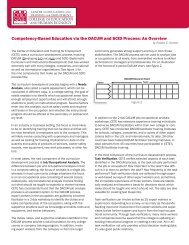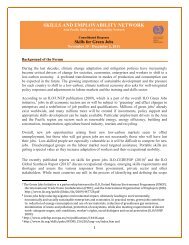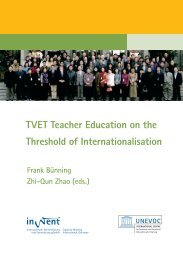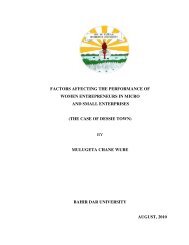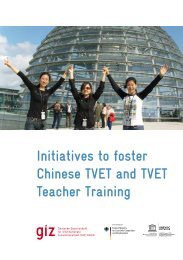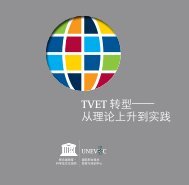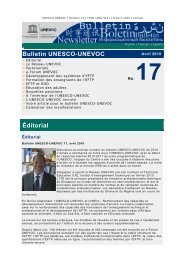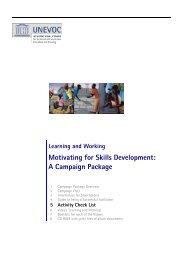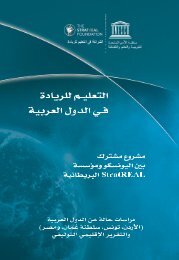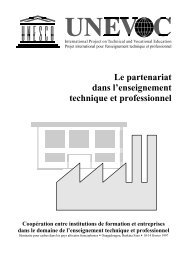Lifelong learning and training: a bridge to the future - Unesco-Unevoc
Lifelong learning and training: a bridge to the future - Unesco-Unevoc
Lifelong learning and training: a bridge to the future - Unesco-Unevoc
Create successful ePaper yourself
Turn your PDF publications into a flip-book with our unique Google optimized e-Paper software.
technicians equipped with a solid base of <strong>the</strong>oretical knowledge <strong>and</strong> practical skills <strong>to</strong> meet <strong>the</strong><br />
increasing dem<strong>and</strong> for technical manpower following rapid industrialization. Specialized<br />
programmes are grouped in<strong>to</strong> technical, agricultural, nursing, fisheries, health, commercial <strong>and</strong><br />
business, home economics <strong>and</strong> so on. In 1997 <strong>the</strong>re were 155 junior colleges with an enrolment<br />
of 724,741, about 28 percent of <strong>the</strong> <strong>to</strong>tal higher education enrolment.<br />
Non-formal vocational <strong>training</strong> comprises public <strong>and</strong> private <strong>training</strong>. Public vocational<br />
<strong>training</strong> is undertaken by <strong>the</strong> Korea Manpower Agency (KOMA) under <strong>the</strong> Ministry of Labour<br />
<strong>and</strong> local governments. It aims <strong>to</strong> train semi-skilled <strong>and</strong> skilled workers through programmes<br />
lasting from three months <strong>to</strong> two years. KOMA manages institutes concerned with a broad range<br />
of occupations, while local governments concentrate on <strong>training</strong> in trades necessary for<br />
increasing <strong>the</strong> income of farm households.<br />
Private vocational <strong>training</strong> is conducted by enterprises <strong>and</strong> corporations. Enterprises are<br />
required <strong>to</strong> pay employment insurance fees, <strong>the</strong> latter depending on <strong>the</strong> number of employees.<br />
The fees paid by <strong>the</strong> enterprises are pooled in<strong>to</strong> a central fund, known as employment insurance<br />
funds, that are used <strong>to</strong> finance <strong>the</strong> vocational competency development programmes. The<br />
vocational competency development scheme, which came in<strong>to</strong> effect in January 1999, replaced<br />
<strong>the</strong> compulsory <strong>training</strong> levy system. Private <strong>training</strong> is also carried out by corporations<br />
authorized by <strong>the</strong> Ministry of Labour.<br />
The duration of vocational <strong>training</strong> programmes vary, ranging from short-term (hours,<br />
days, weeks) <strong>to</strong> long-term (six months <strong>to</strong> two years). The vocational <strong>training</strong> courses are divided<br />
in<strong>to</strong> ‘basic <strong>training</strong>’, ‘upgrade <strong>training</strong>’, ‘job transfer <strong>training</strong>’, <strong>and</strong> ‘re<strong>training</strong>,’ according <strong>to</strong> <strong>the</strong><br />
objective of <strong>the</strong> <strong>training</strong>. The programmes are provided in 477 fields covering 23 technical areas.<br />
In 1997, 477 <strong>training</strong> institutes (96 public <strong>and</strong> 381 private) provided <strong>training</strong> for 302,646<br />
trainees.<br />
RESTRUCTURING OF THE TECHNICAL AND VOCATIONAL EDUCATION SYSTEM<br />
In <strong>the</strong> early 1960s, <strong>the</strong> Republic of Korea was a typical labour-surplus economy with a<br />
modest endowment of natural resources <strong>and</strong> a small domestic market. The government<br />
established a vast economic development plan <strong>and</strong> restructured <strong>the</strong> vocational education <strong>and</strong><br />
<strong>training</strong> system in order <strong>to</strong> supply <strong>the</strong> manpower necessary <strong>to</strong> implement <strong>the</strong> plan. As a result,<br />
most of <strong>the</strong> formal technical <strong>and</strong> vocational education was provided within <strong>the</strong> state education<br />
system, <strong>and</strong> was systematically planned <strong>and</strong> st<strong>and</strong>ardized. The government rapidly exp<strong>and</strong>ed<br />
enrolment in vocational schools in <strong>the</strong> 1960s. However, <strong>the</strong> formal vocational schools were not<br />
able <strong>to</strong> prepare sufficient technical manpower for <strong>the</strong> rapidly industrializing country. In order <strong>to</strong><br />
train enough workers <strong>to</strong> meet <strong>the</strong> increasing industrial dem<strong>and</strong>s, <strong>the</strong> government enacted <strong>the</strong><br />
Vocational Training Law in 1967 as a result of which many new vocational <strong>training</strong> institutes<br />
were established.<br />
∼ 22 ∼



